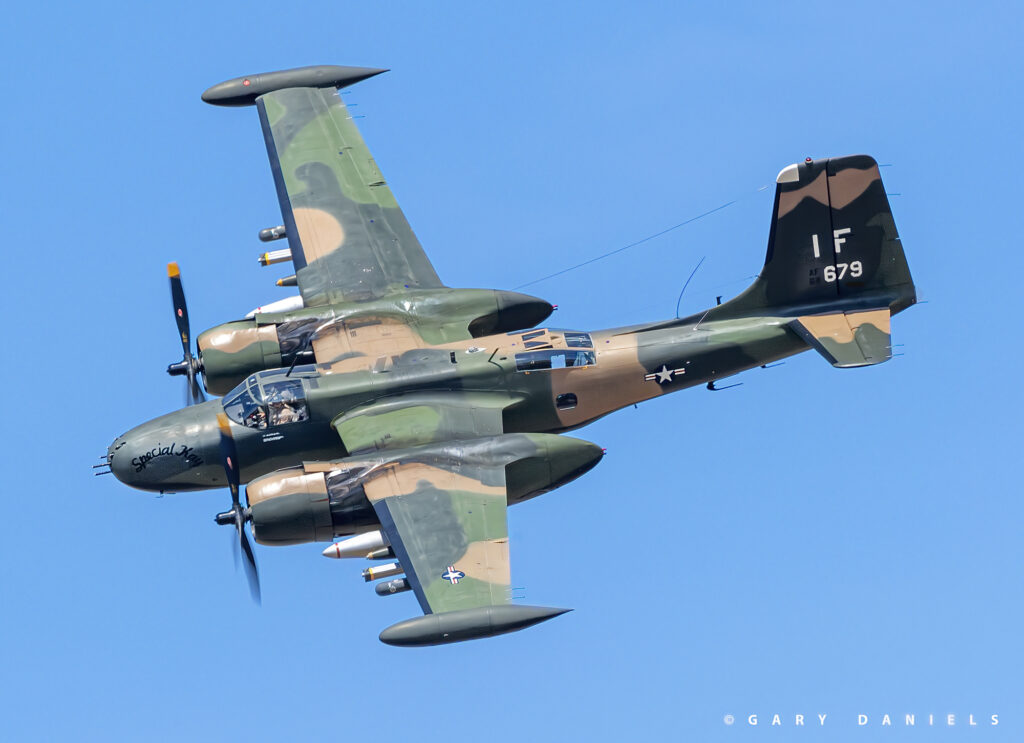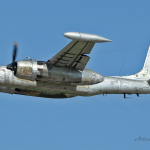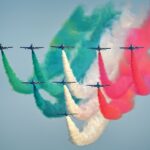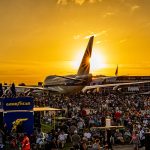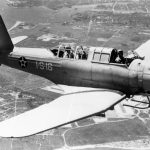By Gary Daniels
Every decades-old, flying warbird has an incredible story to tell prompting one to ask, “How is it even in airworthy condition 60, 70, 80 years after it rolled off the production line?” The answer is each has had several owners since Uncle Sam disposed of it in a garage sale, that protected it while on their watch. Each has had a fortune spent on the myriad of pieces, parts, and engines replaced over the years. Each has been maintained and cared for by thousands of professionals and volunteers throughout the decades. As time marches on, these surviving aircraft become much more valuable than any dollar amount could ever justify. They become historical treasures. And, when one of these treasures is bent in an incident, the pain is felt throughout the warbird community. Such is the case of the B-26K/A-26A Counter Invader s/n 64-17679/N4988N Special Kay, an extremely rare aircraft representing the contribution of the Douglas Invader family from World War II to Vietnam.
On September 9th, 2022, while Special Kay was landing at its home base at Fort Worth Meacham International Airport (FTW) in Fort Worth, Texas, United States, the left main gear collapsed causing the aircraft to settle down onto the runway on the left nacelle, left wing tip tank, and rear fuselage. The aircraft pulled hard left, sliding off the runway and coming to a stop on the parallel taxiway. All propeller blades on the left engine struck the concrete. Fortunately, there were no injuries, no fire, and the right main and nose gear did not fail.
Further damage was caused when the aircraft was hastily crane-lifted, using narrow belts, off the taxiway and placed on a flatbed trailer without padding. This bent the bomb bay doors and the rear bomb bay bulkhead. The aircraft was transported from the taxiway to the Vintage Flying Museum’s (VFM) hangar, offloaded, and put on jacks. The aircraft is owned by PGM Aviation, Inc. which leases hangar space from the museum. One can imagine the dismal emotions of the staff and volunteers as they surveyed the damages. After all, Special Kay had just come out of a major seven-year restoration in 2018. She had been on a successful airshow circuit since and had a busy 2023 airshow season planned.
Upon inspection, the damage was significant. The propeller blade tips were bent and torn; the prop strike also meant the engine would have to be inspected, and possibly overhauled. The left gear would need inspection and numerous structural and sheet metal repairs would have to be made. The Special Kay team, realizing they had another multi-year restoration ahead of them, accepted the hard challenge and went to work.
In the sixteen months since the incident, execution of a repair plan is well underway. A replacement left nacelle, bomb bay doors, wing tip tank, DC-6 propeller blades, and other parts needed have been procured or located. While much of the repair is taking place at the VFM hangar some elements must be sent out for repair. For example, the DC-6 blades will be sent off to be shortened 18 inches to allow for 8 inches of ground clearance. The left Pratt and Whitney R-2800 must be inspected and/or overhauled if necessary. But wait times for large, radial engine repairs are currently 18 to 24 months. This is a major concern and could delay the return-to-flight to late 2025 or early 2026.
On an unseasonably warm and sunny day in early December 2023, this reporter visited the VFM hangar to check on the progress. Patrick Custer, owner of Custer Aircraft Structural Repair Services, was repairing damage in the left nacelle and left wing fuel bay. Concerning the left nacelle repair, Jim Reynolds, restoration leader, elaborated, “The entire nacelle structure will be returned to factory specs or better. Improved metal treatment and modern rivets and fasteners will tighten up the play in the trunnion support area. The right nacelle will get the same scrutiny.”
High up on a ladder, removing bent and scraped belly skins from the back of the bomb bay to the tail, was USAF Technical Sergeant Jordan Harp. Jordan is an aircraft maintainer with the 301st Fighter Wing based at Naval Air Station Joint Reserve Base Fort Worth, which is volunteering time and sheet metal repair. Reynolds pointed out, “The belly skins are being removed, one section at a time, to avoid having to build a jig. There is some crush damage under the skin that will have to be repaired before going back on with new skins. The increase in manpower and expertise from the 301st is really speeding up the repair. We certainly appreciate the help.”
Since December, the left main gear has returned from non-destructive testing (NDT), has been repainted and is ready for reassembly. Once installed, the aircraft will be turned around in the hangar and put back on jacks. This will allow better access for the left propeller and engine removal. The right main and nose gear will also be removed for NDT and repainting. The right nacelle will be inspected as well. The aft bomb bay bulkhead and aft fuselage belly skins will be replaced by mid-spring 2024. All other structural and sheet metal repair will be completed throughout the year. But the long timeframe for the expected engine overhaul is still a major concern and options are being researched. Vintage Aviation News will provide updates on Special Kay’s return-to-flight progress in late 2024.
PGM Aviation, Inc., is a 501c 3 non-profit. To donate funds, services, parts, or to volunteer, follow the Special Kay Facebook page www.facebook.com/a26specialkay and contact the team through Facebook Messenger. You can also donate to the GoFundMe: Help A26 Special Kay Fly
















